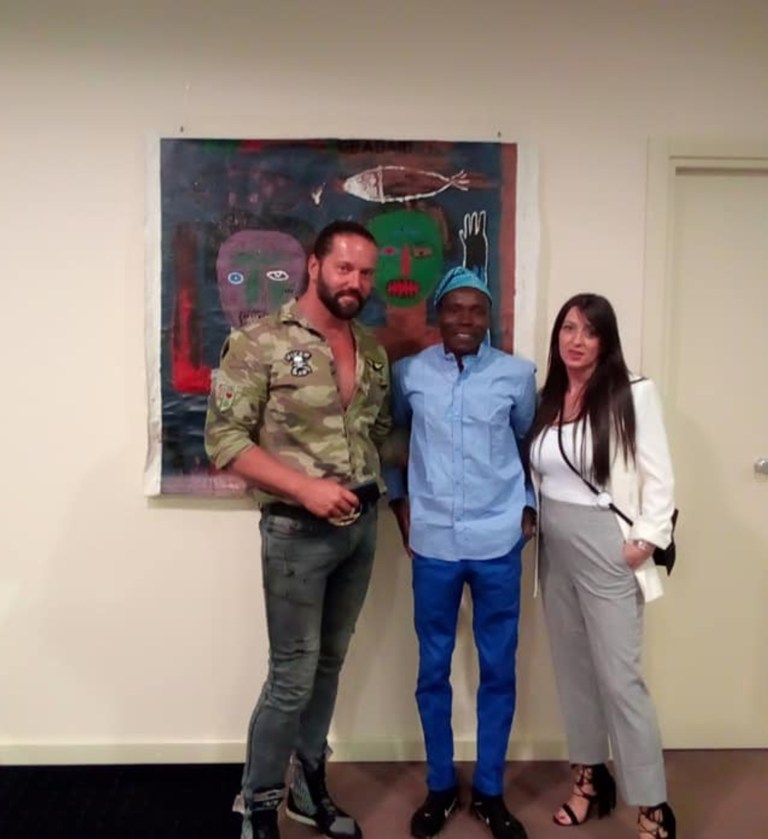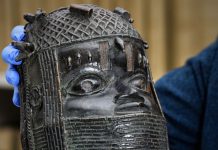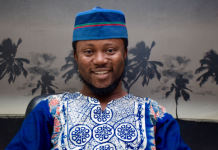Montenegro, a Southeast European country on the Adriatic Sea is currently hosting an international art festival and symposium titled Ode to Life 2019, where artists from different countries came with their pieces of artworks and are also creating other more on the spot at the Millennium Congress Hall Hotel Ramada/Mall of Montenegro, venue of the symposium.
All the artists are showcasing the cultural values of their countries, and Nigerian-born artist, Francis Sewanu Agemo from Badagry, Lagos, whose works have been heavily influenced by the Thron, Atinga and Tovothun, gods and goddess of Ogu people, is representing Nigeria.
Agemo, who spoke to Vanguard in an exclusive interview from Montenegro, said: “My art has evolved over the years through my upbringing with my grandparents who are faithful worshippers of the Thron, Atinga and Tovothun (gods and goddess of Ogu people). I had enriching cultural encounters at the shrine and these have informed my artistic development and visual vocabulary.
“I have over time developed my forms and figures that bear semblance to the objects of worship like totems, statues, masks and raffia threads. My art poses a look at the duality between tradition and contemporaneity.”
At the art exhibition which opened on September 19 and run till September 23, Agemo’s works are attracting a lot attention from other artists, curators and art lovers of other cultures who are obviously fascinated to be witnessing original African culture, especially from the ancient international slave town of Badagry, transmitted to them in art form. This magic, Agemo told Vanguard, is made possible “with my artistic philosophy which I refer to as TraContemporary – A blend of traditions that is not alienated from contemporary realities and transformations.”
A full list of the artists at the exhibition made available to Vanguard contains the names of Roger Dale (UK), Ibrahim Ghazala (Egypt), Leonardo Gironacci (Italia), Saida Hdoubane (Morocco), Faten Khalil (Lebanon), Juman Alnemri (Jordan), Irfan Hozo (Bosnia & Herzegovina), Francis Agemo (Nigeria), Ghada Ali E Al Hassan (Saudi Arabia), Lena Khvichia (Lithuania), Ekaterina Grechani (Russia), Jose ViaGranados (Spain), Emily Shih (China), Jelena Duric (Serbia) and Jules Hunt (New Zealand).
Garry Roost, an actor from UK who is attending the art festival said “Agemo Franscis’ work at The Ode to Life symposium represented the true spirit and depth of his culture. His art brought a unique dimension to the festival.”
Agemo is a kind of historian on canvass. His paintings are mostly metaphorical narrations of fragmental histories and societal discussions, political issues, ancestral rites and abandoned beliefs.
“Most times I tell stories on my canvass about abandoned beliefs, culture and tradition of my people.
One of the famous works of Agemo is titled “The Lucky Woman” which he did during a residency at Alexis Gallaries, Lagos. “This work,” said Agemo, “is talking about a man who has two wives but the first wife is not able to give the man a male child. All her children are girls. So the man is now looking for another wife that can give him the male children he needs. Here, he finds the woman. Though she is ugly and deformed (she has only one eye), she is able to give the man the male child he is looking for.
“The message in this work is that physical appearance – ugliness and deformity – don’t really count when it comes to productivity and achievements. Those things are not hindrances to success in life. There is an inner beauty, and that is what counts. One may look ugly in appearance but the character or product of that person may be what is desirable. The ugly and deformed woman is the one who is able to produce the male child; hence she becomes the lucky woman, which is where the title of the work was derived from.”
Agemo believes that the world is very small. It may be smooth or rough, which is a reality of life; everyday as we go out, we may meet good or bad. Good and bad all work together,” says Agemo.







